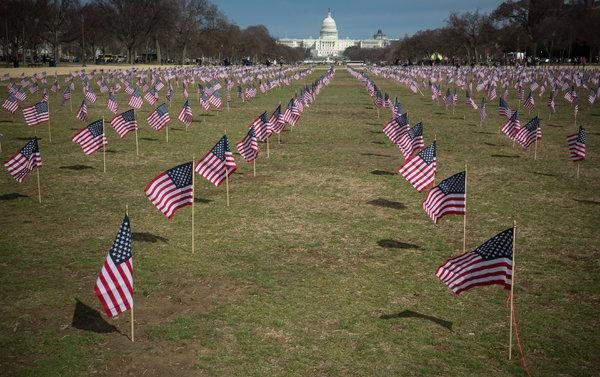
With the department's top management in turmoil, the suicide prevention effort lacked leadership, planning meetings were repeatedly canceled, millions of dollars budgeted for outreach went unspent, and the television and radio ads that had been broadcast thousands of times across the country in previous years went all but silent.
The striking breakdown in prevention efforts is detailed in a Government Accountability Office report released late Monday. The report says that bureaucratic confusion and vacancies in key posts are largely to blame.
In a response released with the report, the V.A. concurred with the accountability office's assessment and said it was already working on correcting the problems.
The suicide rate among veterans is about twice that of the general population, and has been rising among younger veterans who served during the wars in Iraq and Afghanistan.
"At a time when 20 veterans a day still die by suicide, V.A. should be doing everything in its power to inform the public about the resources available to veterans in crisis," Representative Tim Walz, the Minnesota Democrat who requested the investigation, said in a statement. "Unfortunately, V.A. failed to do that."
Mr. Walz attributed the problems to "a deeply troubling level of incompetence" at the agency after a number of experienced senior staff members resigned over differences with President Trump's political appointees.
Among those who left was Dr. Caitlin Thompson, the director of the agency's suicide prevention office. In an interview, she said she resigned in July 2017 because of repeated changes in how the office was overseen and because she felt mounting pressure to produce work that would be politically flashy but have little impact on veterans' lives.
After Dr. Thompson left, the accountability office's report said, the suicide prevention office went nearly idle. It spent just $57,000 of its $6.2 million media budget, and its presence on social media, mostly paid posts, declined by 77 percent from the levels of 2015. Meetings were canceled and decisions were deferred because the acting director who replaced her was frequently absent, the report said.
Since 2012, the office had been regularly airing public service announcements meant to promote gun safety and reduce the stigma around seeking help. But the report found that as of August, none had been broadcast for more than a year.
Dr. Thompson, now with the Cohen Veterans Network, a nonprofit group, said she was dismayed at the falloff.
"This is such an important issue, we need to be throwing everything we can at it," she said. "It's so ludicrous that money would be sitting on the table. Outreach is one of the first ways to engage with veterans and families about ways to get help. If we don't have that, what do we have?"
As the office's outreach efforts dwindled, nationwide monitoring showed a steady increase in the suicide rate among veterans age 18 to 34, which is now about 45 deaths a year for every 100,000 people, more than three times the overall national average.
The suicide prevention paralysis is one of a number of recent stumbles at an agency that has seen significant turnover of experienced staff and top leadership in the last 18 months. Mistakes in managing the G.I. Bill program led to late or incorrect housing allowance payments for more than 80,000 veterans enrolled in college. A sweeping $16 billion overhaul of the V.A.'s electronic health care records system has hit a number of obstacles, and the expert who was brought in over the summer to lead the project quit within a month.
Curt Cashour, the department's spokesman, said the responsibility for the problems in the suicide prevention program lay with Dr. David J. Shulkin, Mr. Trump's first secretary of veterans affairs, who was fired in March. He said Dr. Shulkin's successor, Robert L. Wilkie, had taken steps to address the issue.
"Within weeks of his arrival at V.A., then-Acting Secretary Wilkie appointed Dr. Keita Franklin as V.A.'s new suicide prevention director, and she is reviewing the spending for this important program," Mr. Cashour said in a statement.
A spotlight on the people reshaping our politics. A conversation with voters across the country. And a guiding hand through the endless news cycle, telling you what you really need to know.
Dr. Franklin served as acting director during the time when many of the outreach efforts collapsed. Mr. Cashour did not respond to requests for an interview with Dr. Franklin or comment from her.
When Dr. Shulkin was the department's under secretary for health during the Obama administration, he pushed to make suicide prevention the V.A.'s top clinical priority and to increase spending on the effort. As secretary, he extended mental health benefits to thousands of previously ineligible veterans.
"It was critical to me," he said in a phone interview. "I'm not aware of anything else that is taking the lives of 20 people a day that is a result of service and, in my mind, is totally preventable."
But he said that the departure of many longtime employees in recent years had taken a toll.
"There were a whole wave leaving in 2016 and 2017," he said. "A lot left because of some of the turmoil and internal fighting. You can see it's a real loss."



Comment: Let's not pretend that the vet suicide rate hasn't been extremely high in the US over the past decade. This doesn't stem from an administrative 'mismanagement' issue, although that could be compounding the issue. Here's a thought: stop marching soldiers into illegal and unjust 'wars' that destroy whole societies, and maybe that will reduce the suicide rate.